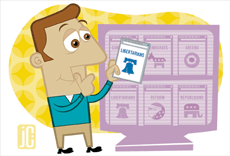The Natural Evolution of the Internet Industry Originally published 4/1/96, revised 8/21/96
by Sky Dayton,
Founder & Chairman,
EarthLink Network, Inc.
State of the Internet industry
Only two years ago, the Internet was virtually unknown in the mass-consumer market. Today, it is a phenomenon reshaping global communications for millions of people. Almost every industry is touched by the Internet's fanatical momentum. It is growing faster than any other new technology industry in history, and it has the potential to change the way people interact on Earth.
In many ways, the Internet's communications properties have acted as a catalyst to its own growth, making it a self-fueling entity.
Despite its growth and its assimilation of whole industries, the Internet is still a nascent market. Many in the industry fear a backlash if the Internet fails to deliver on its hyped potential fast enough. Even now, media pundits have begun to circle overhead looking for the opportunity to strike and be the first to predict such a backlash.
Most agree the Internet will be the foundation of what some call the "Information Superhighway", a communications system that will tie together all existing voice and data applications on an open, inexpensive and fast network. However, the current Internet industry lacks a clear definition of how it will mature toward this vision.
As in all markets, maturity will bring segmentation of products and services within the Internet industry. An understanding and prediction of this segmentation is needed.
Need for definition in the industry
We need a segmentation map of the Internet industry. Without some sort of guideline of how the market will mature, companies will have difficulty putting their potential products and services in context with other companies and in focus within the rest of the industry.
Many large companies today are pursuing unrefined "Internet strategies". Thousands of start-ups are also clamoring to produce products and services for the Internet. Until recently, investors hoping to cash in on the craze were buying any stock with the word "Internet" attached to it, and analysts continue to have difficulty differentiating thousands of new product and service offerings.
Additionally, industry experts are still trying to explain the failures of dozens of previous ventures in the interactive video and proprietary online services businesses, especially those backed by top-tier players such as AT&T, IBM and others.
Companies that don't predict segmentation will have their offerings segmented by market forces nonetheless. Hundreds of companies, from start-ups to blue chips, went through this experience in the PC revolution.
This paper gives participants in this new industry a guide to the coming segmentation, thus allowing them to better define and position their offerings in the context of one another.
The premise of this paper is that Internet market segmentation will be based on the structure of Internet networks themselves.
The OSI model
The Internet marketplace is already segmented in a way analogous to the basic architecture of networking. Network architecture is best defined in the Open Systems Interconnection (OSI) model developed by the International Standards Organization (ISO) over the past 15 years.
The OSI model was created to provide an open-standard reference for network development. It lets network developers work on different parts of the same networking problems in a way that will allow their final work to be compatible with other developers' work.
The OSI model describes the building blocks of all networks. It lays out how a network is built, from the foundation up. Computer networking began as a wire connecting two computers. In order to communicate, the voltage on the wire was modulated. As networking evolved over the years, engineers began building up from this foundation, one layer at a time, with each successive layer allowing greater network functionality.
Much of today's networking technology, including the foundation protocols of the Internet, TCP and IP, was developed without direct reference to the OSI model. So were hundreds of other protocols. However, OSI is an attempt to put networking protocols in context.
Understanding the OSI model
Here is the OSI model:
| Layer | Name | Description | Example |
| 7 | Application | The communications applications themselves. | email, file transfer, client/server applications. Applications such as Netscape & Eudora talk to this layer. |
| 6 | Presentation | Syntax for data conversion, makes session layer available to application layer. | ASCII, binary conversion, encryption and decryption, sockets |
| 5 | Session | Starts, stops and governs transmission order. | Sockets, synchronization |
| 4 | Transport | Ensures delivery of the completed message. | TCP, SNA, UDP |
| 3 | Network | Routes data to different networks. Forms packets. | IP, x.25, IPX, AppleTalk,
Routing |
| 2 | Data Link | Transmits from node to node. Divides bits into frames. | Ethernet, Token ring, Frame Relay, Bridging |
| 1 | Physical | The connection medium. The hard, physical connection. | RTS, CTS, RS-232, copper, fiber, wireless. |
The access sector of the Internet market is currently populated by Internet access, cable and telephone providers. Each company in the access sector can be plotted on the OSI model above.
The company I founded, EarthLink Network, is an Internet access provider focused on the consumer market in North America. For most of our network, we purchase layers 1 through 4 from our partner, UUNET Technologies. They deliver TCP/IP packets (layers 3 and 4) to our customers over dial-up modem lines in hundreds of cities. They, in turn, purchase layers 1 and 2 from local telephone companies. These companies deliver dial-tone or other layer 1 and 2 services to UUNET.
If UUNET can send a ping (a TCP/IP packet from one point to another) to our customer, their job is done - the customer has an Internet connection. We take over at that point and deliver the services the customer uses to communicate on the Internet: email, Usenet, ftp, Web, etc. These services operate on layers 5 to 7.
Early analysts might have seen our relationship with UUNET as competitive. EarthLink predicted industry segmentation, however, and recognized the relationship was complimentary. UUNET decided to focus its business on layers 3 and 4 principally. It buys layers 1 and 2 from carriers and packages the whole thing up into a 4-layer product.
Other Internet access providers, such as Netcom and PSINet, have attempted to build 5 layers at once, all during massive growth. While this strategy made sense early on, these companies will have to defend many more layers against competition. Their competitors will specialize more and more on one or two layers, resulting in better efficiencies than Netcom or PSINet could ever have on a multi-layered strategy.
Since the first edition of this paper was published, PSINet has refocused their business on their traditional core competence: layers 3 and 4. After several quarters of diluted attention and stunted growth, they sold off their consumer dial-up access business and concentrated on business-to-business and wholesale Internet access, where they have always been strongest. With this new, focused strategy, they will be able to compete much more effectively in their market segment.
Other companies have failed to embrace market segmentation by assuming their expertise in lower layers would translate into an advantage in higher layers, particularly where their implementation required them to provide all 7 layers themselves. Today, this is tantamount to IBM's early attempts to own all aspects of the personal computer business.
Recent examples of such disasters were AT&T's foray into computer hardware and online services, USWest's interactive video services and MCI's consumer Internet service. These companies' traditional technology expertise did not translate into expertise on higher layers.
Though telephone and cable companies are pursuing Internet access strategies today, their core business is on layers 1 and 2. With recent deregulation, it is detrimental for them to leave layers 1 and 2 unguarded from major new competition to pursue a completely new business on higher layers.
Layers 1 and 2 are the foundation of the Internet. Because telephone and cable companies were regulated monopolies for so long, they have let this foundation languish. They have not kept up with sweeping innovations in the upper layers. As a result, most consumers now suffer with an Internet experience at a mere 28.8k/bits per second; their computers can process bits thousands of times faster than the network can send them.
The telephone and cable operators have a significant task before them to upgrade and maintain the foundation of the Internet in a newly competitive market. In the long term, they will be more successful focusing on new challenges and opportunities in their traditional lower-layer businesses than pursuing purported opportunities on the upper layers.
OSI model applied to all Internet industry sectors
The OSI model defines how the technology of the Internet underlies the segmentation of its products and services. The industry can also be subdivided into sectors which classify the different types of products and services available on these network layers.
The Internet currently has six market sectors:
- Hardware
- Software
- Access
- Content
- Services
- Expertise
In order to see how companies in each of these sectors operate in the context of one another, all can be classified on the OSI model. The chart on the following page is a random sampling of companies in each sector.
| Name | Hardware | Software | Access | Content | Services | Expertise |
| Application | Apple, Intel, Dell, Gateway | Netscape, Microsoft,
Quarterdeck | EarthLink,
Netcom,
Sprynet, GNN | AOL,
Compusrve,
Prodigy, CNN, WSJ | Yahoo, Excite, Infoseek,
Lycos | CKS, Digital Planet, USWeb |
| Presentation | Sun, SGI, HP, IBM, DEC, Intel | Netscape, Microsoft, Interworld
| EarthLink,
Netcom, Sprynet,
GNN,
Best | AOL,
Compusrve,
Prodigy, BBN
| CyberCash, RSA, Compusrve, BBN, I/Pro, Netcount | CKS, Digital Planet, USWeb |
| Session | Sun, SGI, HP, IBM, DEC, Intel | Netscape,
Microsoft,
Interworld,
Xing,
RealAudio | EarthLink,
Netcom, Sprynet,
GNN,
Best | AOL,
Compusrve,
Prodigy, BBN | BBN, Compusrve, I/Pro, Netcount | CKS, Digital Planet, USWeb |
| Transport | Cisco,
Bay, 3Com,
Wellfleet | FTP, Netmanage, Network TeleSystems | Netcom,
UUNET,
PSINet,
Concentric,
MCI, BBN,
Sprintlink | AOLNet (ANS),
Compusrve, Sprintnet, BBN | BBN, Compusrve,
Network Solutions | Anderson,
EDS, Perot, BBN |
| Network | Cisco,
Bay, 3Com,
Wellfleet | FTP, Netmanage, Network TeleSystems | Netcom,
UUNET,
PSINet,
Concentric,
MCI, BBN,
Sprintlink | AOLNet (ANS),
Compusrve, Sprintnet, BBN | BBN, Compusrve,
Network Solutions | Anderson,
EDS, Perot, BBN |
| Data Link | USR,
Ascend,
Cascade,
Stratacom, AT&T | NorTel,
AT&T | MCI, TCI, Sprint, Worldcom, AT&T | MCI, TCI, Sprint, Worldcom, AT&T | MCI, TCI, Sprint, Worldcom, AT&T | Anderson,
EDS, @Home,
AT&T |
| Physical | USR,
Ascend,
Cascade,
Stratacom, AT&T | NorTel,
AT&T | MCI, TCI, Sprint, Worldcom, AT&T | MCI, TCI, Sprint, Worldcom, AT&T | MCI, TCI, Sprint, Worldcom, AT&T | Anderson,
EDS,
@Home,
AT&T |
Many companies overlap onto different layers in more than one sector. Most companies, however, generally maintain their core business on one or two layers in one sector only.
The OSI model specifies that each layer only deals with the layers immediately above and below it. Similarly, companies will be most successful doing business with other companies on the layers immediately above and below them. As an illustration of this, we have seen many recent failed partnerships between cable or telephone companies and computer software and hardware companies. These companies are many layers apart, as the OSI model shows. The best partnerships are between companies occupying neighboring layers.
Also, complications in developing and deploying networks and network-based products are directly proportional to the number of layers involved. Conversely, the fewer the layers involved, the simpler and more reliable the networking technology.
With more layers involved, the technology becomes more complex, but it also allows much greater flexibility. For example, Morse code operated at the first layer only, and telephone technology deals only with the first and second layers. Both afford little room for innovation compared to the seven-layer full Internet connection.
Because Internet technology is so versatile, it will be difficult to fit the industry into a "commodity" description. While one or more layers may become commodity businesses, there is so much flexibility in the implementation of multiple layers, it will be a long time before the entire industry commoditizes, if ever.
Summary
The Internet has the potential to become the greatest communications medium in history. It will take thousands of developers at hundreds of companies to provide the innovations necessary for the Internet to achieve this potential. Whether or not these companies become a financial success depends largely on their anticipation of the market's segmentation.
Many companies will not foresee this segmentation and will fail to position themselves to occupy a layer, or segment, of the industry. Or they may pursue a segment but fail to understand its relationship with the layers immediately above and below.
Companies that understand and embrace the natural segmentation of the marketplace will be able to make wise decisions about partners and competitors. By anticipating changes in the market, these companies will be principal contributors to the Internet of the future.



















 The Internet is the first mass communications medium that allows any two people anywhere to connect with each other, and allows someone to search and sort information to find new people.
The Internet is the first mass communications medium that allows any two people anywhere to connect with each other, and allows someone to search and sort information to find new people. 

